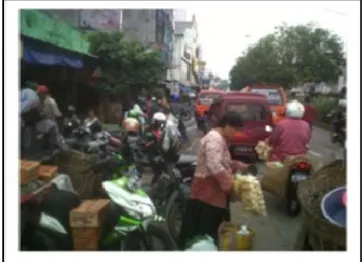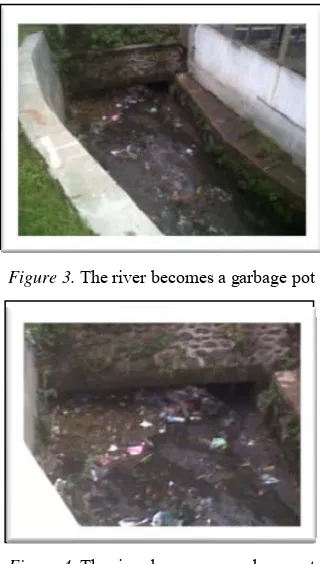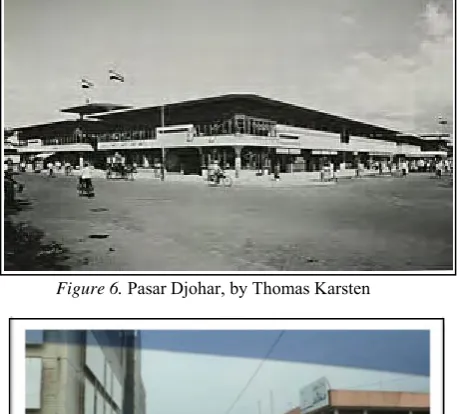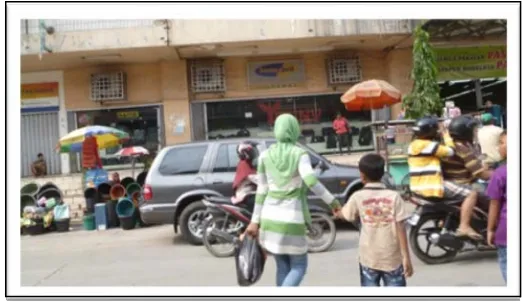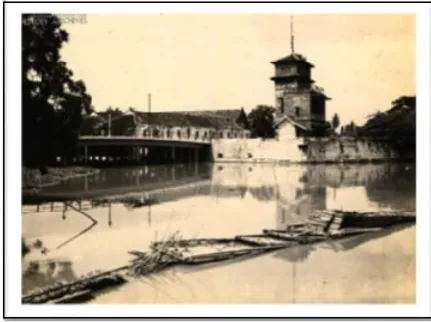54
International review for spatial planning and sustainable development, Vol.2 No.4 (2014), 54-67 ISSN: 2187-3666 (online)
DOI: http://dx.doi.org/10.14246/irspsd.2.4_54
Copyright@SPSD Press from 2010, SPSD Press, Kanazawa
Local Wisdom As The Ontological Foundation To
Postmodern Urban-Design In A Developing Country
The case of Semarang city, Mid-Java, Indonesia
Rudyanto Soesilo1*
1 Faculty of Architecture & Design, Soegijapranata Catholic University * Correponding Author, Email: [email protected]
Received 21 November, 2013; Accepted 27 April, 2014
Key words: Ontology, Local-wisdom, Postmodern urban planning and design, developing-country
Abstract: Cities in a developing country play a role as a growth-pole, with high economic activity. This role, acts as a great magnet for low income rural people - who still live in a cosmocentric ontology - to migrate to the cities. This condition becomes a real challenge to urban designers in a developing country. The rural migrants accumulate as the majority of inhabitants and if they are not considered carefully there will be many problems to the city’s life, include the emergence of slums and shanties. Semarang is the municipal of Mid-Java province in Indonesia, a developing country. A significant case among many others, Semarang can be found at the Djohar traditional market at the center of the city. The traditional market was designed by famous Dutch olden-times architect, Herman Thomas Karsten. The market was designed for ordinary low-class people complementary to the Bojong shopping street, which was designed for the Elite Dutch class. Indonesia proclaimed its independence on August 17th
1945. About the year 2000, some investors tried to change Djohar and its surrounds into an elite shopping area. This effort failed. The low-class people still exist in this area. This tells us about a different urban planning and design solution for different communities living in a city. A specific treatment in urban planning and design in a developing country that fits the worldview of the people living in it is required: Postmodern urban planning and design, with local wisdom as the ontological foundation.
1.
INTRODUCTION: SOCIAL REALITY IN A
DEVELOPING COUNTRY, DIFFERENT
ONTOLOGY, DIFFERENT WORLD-VIEW,
DIFFERENT BEHAVIOUR
“…Kahn advocates for creating all new cities, saying, “If you don’t create new cities, every existing city will be a slum…”
Figure 1. Peterongan Street, trottoir and the body of the street turned into shopping area
The low-income community comes from the rural area and has their own world view, a cosmocentric ontology (the worldview that humans have been ruled by an external superpower), entering the city with recent development in the modern paradigm and modern ontology. This different ontological foundation plays as the root of a wider and wider gap as time goes by and the population grows larger and larger. At the time being, the gap between the Haves and the Have Nots is growing fast, the Haves create enclaves of the exclusive community such as real estate, gathering and clubbing facilities, shopping areas, business areas, all in an exclusive way. While the Have Nots occupy the public spaces and change it into an onstreet “shopping area” (Figure 1 and Figure 2).
Figure 2. Peterongan Street, the tottoir and the body of the street turned into shopping area
To solve the problem of a city as the habitat of the citizens with different world views, we can use the postmodern approach which accepts and combines the modern approach and the traditional-local wisdom appproach together to look for a better solution.
The local-wisdom as a traditional cosmocentric view brings a familiar solution to the migrant population as an ex ruralist. From this point of view we can make a plan, a design for a city in this developing country, which can match the needs of each cluster in a win-win solution.
Ferdinand Toenies divides people into two layers, Gemeinschaft and Gesselschaft. Urban people are identified as Gesselschaft or Society while
rural people are identified as Gemeinschaft or Community. They have
different worldviews and different ontologies. Ontology is a human self-perception, where someone posits his or her self in the constellation of this universe. This perceived position creates a worldview, and different self-perceptions create other worldviews. That happens in the case of the Urbanists and Ruralists. This different ontology, different worldviews, leads to different behaviours being practiced while living in the cities.
The Ruralist does not obey the city’s rules, regulations and conducts, Ruralists cannot understand all of that because all the rules and regulations are based on a modern individual ontology, while the Ruralist lives in a communal ontology where they belong each to one another. This
Gemeinschaft ontology is what postmodernism calls one of the
local-wisdoms, that is, the social reality in a city in a developing country that urban planners and designers have to give attention to a successful urban-solution which can be accepted by many layers of the inhabitants in the city.
2.
INDONESIAN URBAN MANAGEMENT
PROBLEM
Globalization as a manifestation of modern capitalism is now a worldly phenomenon. Globalization grips the whole-world including developing countries like Indonesia. Globalization has very wide spectrums from the economics realm to global urban life-styles; triggering many demanding needs of many urgent urban-facilities such as modern shopping malls, apartments, hotels, office buildings and recreation areas. The demanding needs run very fast and rules and codes are often “by-passed” to meet them. The gap between the Haves and the Have Nots results in the emergence of an urban design solution, referred to here as an “elite-enclave among slums”. An elite area with very luxurious facilities, but is besieged by slum areas around it. This urban model encompasses many developments in real estate and properties, including many urgent urban facilities such as modern shopping malls, apartments, hotels, office buildings and recreation areas. In all the urban areas, there appear many “elite enclaves” like “beautiful islands” among slums. Adopting the international, modern style, where buildings lay singular - that “beautiful island” which stands arrogantly and looks like it “has nothing else to care about” regarding the poor realities surrounding it. From one building to another, pedestrians have to risk their lives, by walking in very crowded and dangerous zones. Capitalism, globalization and modernism result in the widening of the gap between the rich and the poor in an urban development in a developing country(Soesilo, 2011b).
Figure 3. The river becomes a garbage pot
Figure 4. The river becomes a garbage pot
The root of this custom lays with the traditional ontology which accepts the river as the backside, here referred to as “waterback”, aconcept of space
(As compared to the concept of “waterfront” architecture). The traditional ontology believes that a mountain is the home of the good spirit, while the sea and the river are the homes of the bad spirit, so the design of a building is back to back with the river. The river as a backside becomes a service area, and it can be a place of dirt, garbage, dark, and squatter (Figure 5).
Traditional Javanese poetry expresses the ontology: “E dayohe teka, e gelarno klasa, e klasane bolong, e tembela gemblong, e gemblonge mambu, e pakakna asu, e asune mati, e guwako kali . . . .”, meaning to throw
away garbage like the dog’s carrion to the river.
Figure 5. Colonial building along the Semarang River, the Waterfront Dutch design
2.1
The dichotomy of people-space and elite-space
society cannot be blended together; each has tradition, logic and specificities of their own.
2.2 The “Pasar Djohar” case, Semarang
Pasar Djohar located in Semarang city, is the fourth largest city in Indonesia, geographically lying between Jakarta, the largest city of Indonesia and Surabaya, the second largest. With about 3 million people living there, Semarang is an example of an urban setting in a developing country. Semarang is a city on the north coast of the island of Java, Indonesia. It is the capital and largest city of the province of Central Java. It has an area of 373.70 square kilometers (144.29 sq mi) and a population of approximately 2 million people, making it Indonesia's sixth most populous city and Indonesias fifth largest city after Jakarta, Surabaya, Bandung, and Medan. Greater Semarang (also known as Kedungsapur) has a population of close to 6 million and is located at 6°58′S 110°25′E. It was a major port during the Dutch colonial era, and is still an important regional center and port today. The city has a dominant Javanese population.
The “Pasar Djohar” case, (Soesilo, 2006), (“Johar” in new spelling. Pasar means traditional market) is a case about a colonial market in Semarang, designed by Thomas Karsten, which has been surrounded by traditional markets and a night market called “Pasar Ya’ ik”. The atmosphere of the whole great market is as a traditional market for many merchants in Semarang and from the hinterland, such as Kendal city, Kaliwungu city, Purwodadi city et cetera. The public space of the Djohar great market becomes a traditional space which matches the people and merchants who use it.
A “space” then has a deep meaning, because in that space, people live, do activities and make their life meaningful. A “Space” is not just a mere two-dimensional plot, but three-dimensional place to cultivate the human existence for its users. ‘People-space ' indicates an area in which 'the people', that in a developing country means 'ordinary people’, marginalized communities and the populous (usually the Have nots), organize their life.
‘Pasar Djohar’ (Figure 6), was initially designed by pro-Indonesian
Figure 6. Pasar Djohar, by Thomas Karsten
Figure 7. Pasar Djohar, 14th February 2014
‘Pasar Djohar’ was designed as a public market, as a space for ordinary people to interact. By architect Thomas Karsten, the Djohar Market is designed as a complement to ‘the Bodjong’ area , now Jl. Pemuda Street was the elite shopping center at that time (Figure 7 and Figure 8).
Figure 8. The atmosphere inside the market, a Gemeinschaft relationship (Johan, Semarang Kota)
and very popular, has declined and the developer has established yet another shopping center, called Ya'ik Permai. So the ‘benevolent’ developer has
always left a heritage name as their sign of thoughtfulness. Along the way, SCD was later destroyed and replaced with ' Matahari Djohar', which was pursued as another new magnet that wanted to create a new enclave for the Haves. This seizing failed again, evidence that it is difficult to mix the space between two layers of people. The ordinary people, consistently, have re-captured the public space and created a new traditional market, selling along the overhang of the Matahari, where the atmosphere has become strange. The people selling in doorways penetrate to the crammed streets, while a thousand square meters of shopping floor next to them are empty and unused (Figure 9). Tragically the Semarang City Government in cooperation with
other developers, many times, have created plans to seize and change the Djohar People's Market, continuing until today.
Figure 9. Kaki 5 (means a 5 foot, unlicensed street vendor) in front of formal shops at Matahari Dept. Store, Johar
Pasar Djohar, then becomes the last stronghold for the 'ordinary people’ in maintaining the environment which matches with their activities, their behavior and their ontology. The Pasar Djohar location is easily accessible by public transport¸ which is better value than it should be for the ordinary people and is not needed by the upper-class people who have many other modes of personal transport. That ease, equips Pasar Djohar as a 'mostly good' public space for the city people and for the ‘ordinary people’, supporting those from the hinterland of Semarang, like Kendal and Kaliwungu namely, which since the colonial era, has allowed ‘ordinary people’ to always feel at home and satisfied when making a trip to Semarang, just after visiting Djohar. This Pasar Djohar case highlights the significant relationship between public spaces with the ontology of the people who use it.
3.
THE IMPACT OF POSTMODERNISM ON
URBAN PLANNING AND DESIGN IN
INDONESIA
historicism, feminism, deconstructivism, different paradigms, pro ecology and populism (Lyotard, 1989). Soesilo (2011a) states that populism, as a political ideology or rhetorical style, holds that the common person is oppressed by the "elite" in society, who exist only to serve in their own interests, and therefore, the State needs to be distanced from this self-serving elite and instead focussed toward benefitting and advancing its people as a whole. A populist reaches out to ordinary people, addresses their economic and social concerns, and appeals to their common sense.
3.1
Ontological foundation of postmodern urban
planning and design
Ontology is human self-perception, where someone posits his or her self in the constellation of this universe. This perceived position creates a worldview, and different self-perceptions create different worldviews.
Urban planning and design is a part of human culture. It is an effort of humans to be civilized and to create order for the space they live in. This effort is a projection of what they perceive about “who” they are. Every kind of society creates an order of their living space, which will be different from others. Each perception of their selves is what is called ontology, which defines specifically each person’s living space. In the 1970s the postmodern movement arose, which impacted every aspect of human life, including efforts to plan living spaces and urban planning and design. Postmodernism gives a place again to traditional worldviews; local wisdom as another “truth” amongst many other “truths” such as modernism. For postmodernism, there is equality amongst these “truths”, nothing is superior.
3.2
Local wisdom as the ontological foundation to
postmodern urban design in a developing country
A developing country consists of heterogeneous people and heterogeneous communities: the Haves and the Have nots, educated middle-class and low educated low-middle-class, et cetera. The worldview gaps of urban inhabitants in a developing country are widely ranging and varied. That will be one of the differences compared with the modern approach to urban design in the setting of a developed country. In a developing country, cities act as a growth-pole, where industry takes its place and offers a higher income than in a rural agrarian area. This was the trigger of the urbanization phenomena in a developing country. This phenomenon creates a specific urban atmosphere, which needs specific urban planning and design. This phenomenon needs a specific treatment, or if not, means it will be treated with a “developed country approach”, that will create what we called “slum areas” and shanties.
Based on Soesilo (2008), the ability to understand and then, the ability to practice postmodernism’s value, the conditions of postmodernism must be fulfilled. First, we have to be modern, because postmodernism begins at the time when the late-modern condition ends. Cities do not just have to be modern, but should have been late-modern, before entering the postmodern paradigm. Without passing that episode, cities are set back to the pre-modern condition, hence traditional ritual, but with different cosmology, can now be acted on.
a city’s inhabitants. From this standpoint it will raise a new approach of urban planning and design in a developing country in a way of “not forgetting” the migrants and even “accepting” the migrants as a reality in a developing country and entering this reality as one of the urban design determinant.
3.3
The impact of postmodernism on urban planning
and design
Postmodernism offers many values to urban planning and design, as brought about by a broad post–1960s – 1970s shift in sensibilities, and had specific manifestations within the planning discipline. Postmodernism is used as an “umbrella” term and covers multiple ideological transitions in relation to planning and policy manifestations as outlined by Hirt (2005):
A shift from expert-driven toward participatory processes.
From a planning view assuming the supremacy of new, “modern” forms toward a view appreciative of historic structure
From a planning focus on functionalism and efficiency toward a focus on human scale, urbane, and unique forms
From planning in favor of technologically efficient, functionally separated forms, to planning in favor of more urbane, mixed-use forms
In urban planning and design there are five related aspects of postmodern urbanism within the broader context of the postmodern shift, also outlined by Hirt (2005), as follows:
A growing interest in participatory planning (in lieu of the former dominance of rational planning performed by value-free experts)
A search for urbanity, urban identity, and cultural uniqueness (in lieu of the former focus on functionalism, efficiency, and rational organization of urban forms)
An appreciation of historic spaces, a return to traditional urban forms (in lieu of the modernist belief in the supremacy of new forms)
A mixing of land uses and flexible zoning (rather than strict land-use segregation).
The pursuit of human-scale, pedestrian friendly, higher
density, urbane and compact forms (in contrast to spread-out, low density and auto orientated forms).
4.
LOCAL WISDOM AS THE ONTOLOGICAL
FOUNDATION TO POSTMODERN
URBAN-DESIGN IN INDONESIA
4.1
Semarang as a postmodern city
Starting as a colonial modern city, Semarang should now enter the era of a postmodern city. Semarang has evolved with various satellite towns, such as Tanahmas, Bukitsari, Puri-Anjasmoro, Ngaliyan, Tlogosari, Banyumanik et cetera. Those satellites were quite advanced and successful by developing the centres of each (multipolar city), in other zones the industrial centres also grew as separate satellites.
Since the 1970s the turbulence of the human mind has left modernism. The world has shifted from modernity, that has given rise to the ecological crisis, global warming, and humanitarian crisis - including city planning paradigms – and replaced them with a postmodern paradigm that is pro-ecology, pro-people (ordinary-people) and“put(s) people first”. It is also pro
local-wisdom and pro-history (Soesilo, 2011b). The postmodern paradigm based on participatory planning and design, invites the community to get involved in urban environmental planning. The commitment of pro-people also realizes the concept of community empowerment and community-based development. Postmodern cities do not ruilslag (Dutch, to demolish and
build new investment buildings), destroy, displace, nor decay heritage buildings, but integrate them with new district-planning, or just separates them, conserving the old city area and accommodating the desire for new developments in brand new zones, like La Defense in Paris. Ultramodern
zones can be developed with brand new rules and conduct, while the atmosphere of the most romantic town, the city of Paris with all the cafés, can still be enjoyed. Imagine if people were in Paris and only found a city full of glass and concrete!
By adopting postmodern paradigms and urban development, city residents escape from isolated feelings and alienation, because of modernist arrangements that gave birth to the islands of towers, so that if people wanted to move from one building to another they were forced to use a car like in Jalan Thamrin Jakarta, where people have been alienated in a metropolis concrete and glass jungle. In the postmodern city, the Kaki-5 street vendors should not be evicted in vain, but arranged, organized, and facilitated in a "Semarang Bazar", which is interspersed with a variety of festivals, such as the Warag Ngendhog and Dhugdheran festivals, following the postmodern paradigm which embodies the people in nearly all the city's public spaces. Facilities for pedestrians and the disabled are available and well-kept and beautifully designed in the tropical climate according to the coastal city of Semarang, with special vegetation.
4.2
Performances of postmodern folk art: Society in a
postmodern city
dynamics. The reality of the greatest layer of the people in a developing country like Indonesia and Semarang is that their needs are actually being met and well-arranged in the city's public spaces and not denied or concealed.
Comfort criteria to inhabit a city for most citizens, based on a survey of the IAP (Association of Urban Planners), includes the quality of the city’s layout, the amount of open spaces, the quality of public transport, protection of historical buildings, sanitation, pollution, road conditions, facilities for pedestrians, disabled people, health, education, clean water, telecommunications networks, public services, relationships between people, electricity, and recreational facilities. Because the surveyed criteria were indeed referring to the postmodern paradigm, it’s true that the various criteria will be met by running the postmodern paradigm.
The “pro-people policies” means that the ordinary-people have the provision of open space and a pro-history influence toward adequate city planning, which protects historic buildings and assembles them with the new buildings of today. That policy improves the uniqueness of recreational facilities for the city’s guests who bring life to the city, which allows sufficient budget to improve the electrical grid, water supply, telecommunications, public services, the availability of subsidies for education, health, and improved road conditions. Available, in good condition and well-maintained facilities, cause investors to invest in the city; the investments open job opportunities for city residents. So there is a chain reaction that always leads to ongoing improvements.
Semarang is not in Yogyakarta, but Solo instead (Yogyakarta and Solo lay in Mid-Java, and were the former municipals of traditional Keraton of the Javanese kingdom, favoured as cultural heritage cities).That is precisely the strength of Semarang. Starting from the functional colonial modern city, Semarang has now moved to being a postmodern city without any constraints. Semarang can develop postmodern art in every corner of the city, developing centres of youth activity that have long been forgotten, so that the children and the younger generation should no longer play in the streets, and teenagers no longer hang around in shopping malls. Youth activity centres which can invigorate postmodern art as well as traditional and modern art rose simultaneously. With the Greenship paradigm, residents and bureaucrats can overview Semarang city as a very large, green landscape in which there can be organized the architecture of residential areas, commercial centres, leisure centres, and centres of education and industry. Not the reverse view, that Semarang city is seen as a scattering of various buildings with the open spaces only as the remnants. With this postmodern green paradigm, ‘a Green Semarang’ was created with a sprinkling of postmodern artwork that can be appreciated by all the people from many layers. Sculptures, murals and digital works are all included, so the public spaces of the city become very large stages presenting the spirit and passion for the art and the awakening of the appreciation of the youth of Semarang.
Indeed, to achieve the “postmodern Semarang city" the action and determination of the residents is needed. If you come to Yogyakarta, we feel how Yogyakarta people appreciate "the town guests", the tourists. So Semarang residents need to learn about it. and must develop the spirit of receiving guests. For example, traditional songs must be remembered: "E dayohe teka, e gelarna klasa" The traditional Javanese poetry which
guwako kali . . . .” meaning to welcome guests, to spread out the red
carpet for the guests.
Solo city, which is actually loaded with various symbols as a cultural city, has been able to break the eggs as a city management model that is "fit" as a typology of a cultural heritage city. Semarang city with different typologies, as has been discussed, would seem to solve the other eggs by becoming a model of sophisticated urban management, a postmodern Semarang city.
4.3
Another postmodern chance in Semarang
Indonesia has a great chance to implement postmodern values into its urban planning and design policies. Some postmodern values such as: incredulity towards metanarratives, pluralism, incommensurability, genius loci, historicism, feminism, deconstructivism, different paradigms, pro ecology, populism, and others, can be implemented within policies that benefit ordinary people, the environment, and public interest (Soesilo, 2010).
4.3.1 Reclamation and old harbour development control
The desire to adopt “the marina trend” (as done in Singapore) by the elite and many developers can be re-oriented to a kind of conservation and preservation solution that can be implemented to many old historical harbour areas. This urban policy can simultaneously control the development of the old harbour area without demolishing the old historical buildings, and control the stopping of the city’s river through the reclamation of the Marina. There, there arises an egalitarian collaboration between the government, the developer, the old building’s owner, the user and the wider community.
Figure 11. The old harbour of Semarang
4.3.2 Public space for ordinary people
The city residents of a developing country like Indonesia are very widely spread across many different categories: the elite rich (the Haves), the middle-class, the street-retailer (Kaki-5 vendors), the service worker, the homeless, the commuter, and many others. To manage the reality that there is a “big gap” between “the Haves and the Have Nots”, there must be “pro-people” urban policies. In public spaces, where all the modern facilities are found, where there are malls, hotels, apartments and rental offices, the Government will provide an open space for the traditional Indonesian bazaar as the place for the “street retailers”. This traditional Indonesian bazaar can be an attraction with a cultural agenda for the city; actually it can be a tourism destination too. These “pro-people urban policies” hopefully can bridge the public interest with the elite’s. This policy builds collaboration between the elite, middle-class and the street retailers as well.
4.3.3 The pedestrian centred urban public space design
The pedestrian centred urban public space design, especially in this tropical climate, can allow a comfortable walk in and around a city. This can raise the enthusiasm of people to live healthily in the city. The multi-storey high-rise buildings are linked with each other with sheltered pedestrian walk-ways; they are not standing alone arrogantly anymore. People are infiltrating into the shrubbery and enjoy the tropical gardens in the heart of the city.
5.
CONCLUSIONS
any decision in urban planning and design. The postmodern worldview accepts and appreciates the local wisdom and places it as a foundation in treating people in equality because postmodernism believes in plurality.
Semarang, the municipal of Central Java province in Indonesia is a coastal tropical city, can be a significant example of doing urban planning and design in a developing country with deep concern for local wisdom as the ontological foundation towards a postmodern solution.
REFERENCES
Hirt, S.A. (2005). “Toward Postmodern Urbanism?”, Journal of Planning Education and Research, 23, 27-42.
Hansen, S. (2014). “What does urban planning offer to developing world?”, Sourceable, industrial news & analysis, 17th February 2014.
Lyotard, J. F. (1989). The Postmodern Condition, a report on knowledge. University Press, Manchester.
Soesilo, R. (2006). Ruang rakyat Johar (Johar as the public space), Harian Kompas Jateng. Soesilo, R. (2010). The Postmodern paradigm In Urban Planning and Design in Indonesia.
Seminar: Reframing Java: Past, Present, and Future” August 3, 2010
Soesilo, R. (2011). Populisme Kampus, Wahana untuk Kebangkitan Bangsa (Populism in campus life, a key to the rise of the Nation), Pidato Dies Universitas Katolik Soegijapranata, Semarang, 5 Agustus 2011. (Dies Natalis Speech)
